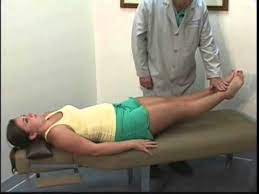Special tests for the dysfunction of the lumbar spine
Special tests are crucial in assessing and diagnosing dysfunction in the lumbar spine, which is the lower back region.
- These tests are applied to the clinic to check the joint dysfunction of the lumbar spine.
- These clinical tests are applied by to therapist when the patient is complain about lower back pain.
- These tests are applied after the patient is already completed the diagnosis with the x -rays.
- These tests are applied to the examination part of the assessment of the back pain.
Name of the special tests of joint dysfunction of the lumbar spine:
- Milgram’s test
- One – leg standing lumbar extension test
- Quadrant test
- Schober test
- Yeoman’s test

Milgram’s test:
- Purpose = This Milgram’s test is used to check the neurological symptoms in the leg.
- Technique = The starting position of the patient in the supine position.
- Then the examiner instructs the patient to actively lift both legs simultaneously off the examining table 5 to 10 cm [ 2 to 4 inches ], holding this position for 30 seconds.
- Result = the test is positive if the limbs or affected limb cannot be held for 30 seconds or if symptoms are reproduced in the affected limb.
- This test should always be performed with caution because of the high-stress load placed on the lumbar spine.

One – leg standing lumbar extension test:
- Purpose = This one-leg standing lumbar extension test is used to check the facet joint pathology.
- Technique = The patient stands on one leg & extended the spine while balancing on the leg.
- The test is repeated with the patient standing on the opposite leg.
- Result = a positive test is indicated by pain in the back & is associated with a pars interarticularis stress fracture [ spondylolisthesis ].
- If the stress fracture is unilateral, standing on the ipsilateral leg causes more pain.
- If rotation is combined with extension & pain results, this indicates possible facet joint pathology on the side to which rotation occurs.
Quadrant test:
- Purpose = This quadrant test is used to check the maximum narrowing of the inter vertebral forearm.

- Technique = The patient stands with the examiner standing behind the patient.
- Then the patient extended the spine while the examiner [ therapist ] controlled the movement by holding the patient’s shoulder.
- The examiner may use his/her shoulders to hold the occiput & take the weight of the head.
- Over pressure is applied in extension while the patient side flexes & rotates to the side of pain.
- The movement is continued until the limit of the range is reached or until symptoms are produced.
- Result = The position caused maximum narrowing of the inter vertebral forearm & stress on the facet joints to the side on which rotation occurs.
- the test is positive if symptoms are produced.
- Cipriano described a similar test of quadrant test as Kemp’s test.
Schober test:
- Purpose = This Schober test is used to check the amount of flexion occurring in the lumbar spine.
- Technique = The Schober test may be used to measure the amount of flexion occurring in the lumbar spine.
- A point is marked midway between the two PSIS Means dimples of the pelvis, which is the level of S2.
- Then points 5 cm [ 2 inches] below & the 10 cm [ 4 inches ] above the level are marked.
- The distance between the three points is measured, the patient is asked to flex forward,& the distance is remeasured.
- The difference between the two measurements indicates the amount of flexion occurring in the lumbar spine.
- Little-reported a modification of the Schober test aviable to measure extension as well.
- After completion of the flexion movement, the patient extended the spine,& the distance between the marks is noted.
- Little also advocated using four marking points with 10 cm [ 4 inches ] between them.
Yeoman’s test:

- Purpose = This yeoman’s test is used to check the pain in the lumbar spine.
- Technique = the patient lies prone position for the test.
- The examiner [ therapist ]stabilizes the pelvis & extended each of the patient’s hips in turn with the knee extended.
- The examiner [ therapist ] then extended each of the patient’s legs in turn with the knee flexed.
- In both cases, the patient remains passive.
- Result = A positive test is indicated by pain in the lumbar spine during both parts of the test.







